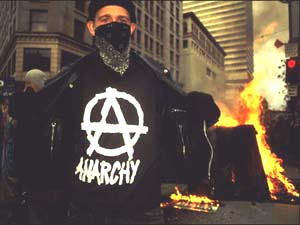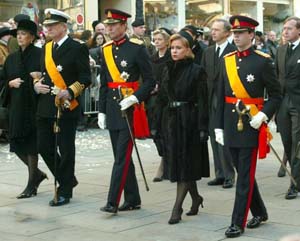 |
Traditionalist Issues
The Liberal Spirit vs. the Catholic Spirit
Plinio Corrêa de Oliveira
Question: Could you analyze why a person with the liberal spirit always looks for half-truths, while one with the Catholic spirit as lived by the Saints – for example, St. Louis Grignion of Montfort – always seeks the radical truth?
Answer: A first distinction must be made. A man outside the Church with a liberal spirit generally looks for radical truths, like the men who made the French Revolution. It is the liberal Catholic inside the Church who looks for half-truths. With this distinction in mind, I will try to describe first, what characterizes the liberal spirit vs. the Catholic spirit, and second, to what degree the liberal mentality filtered into the mentality of the Catholic liberal.
Characteristics of the liberal spirit
The starting point for the mentality of a liberal is that he does not accept the truths that are external and extrinsic to himself. He only looks for those truths that please him. He looks for doctrinal panoramas that suit his temperament, convenience and way of being. This constitutes the foundation of the liberal mentality in the intellectual sphere. In the practical sphere, in the realm of action, he only wants to do only what he likes. Everything in the liberal mentality flows from these two sources.

Above, libertarians who reject laws and restraints; below, an anarchist
 |
The liberal is a subjectivist because he only likes the truth that fits his way of thinking and being. He doubts everything that does not suit him. This is why he is favorable to free examination of Scriptures, historical criticism, and introducing the spirit of doubt into every field of thinking. He never doubts, however, what agrees with his way of living.
The liberal is against laws in general, because laws emanate from an authority that orders him to do what is good for society; therefore, everyone must obey them. Since this presupposition does not take into account his personal preferences, he does not want to have laws. The extreme liberal is an anarchist, the person who will not admit any authority, any law or any institution; a person who follows his own whims.
The liberal is also against dignified clothing because he wants to be completely free from any kind of coercion or protocol. When the liberal is consistent, he will support nudism. Even when he does not reach this extreme, there are some pieces of clothing that he particularly hates: the collar and the tie strangle him; the garter to keep socks straight cuts his circulation; the belt squeezes his waist cutting him in two; shoestrings are oppressive and too much bother – better to use moccasins, or better yet, go barefoot; he also hates shirts with French cuffs and cufflinks - for this reason both have almost disappeared.
Is there a unifying point in these two fundaments of the liberal mentality – to accept only the principles that fit his lifestyle and to do whatever he wants? Whenever a mentality has two or more common characteristics, a point of unity must be present. I believe the common denominator here is egoism. The liberal is concerned only about his ideas, his own will, his convenience and comfort, and his personal preferences. He is self-centered. This is what defines egocentrism or egoism.
Characteristics of the Catholic spirit
The Catholic takes a diametrically opposed perspective. He understands that outside him is a universe enormously greater than himself, of which he constitutes only a small part. Then, as he considers the universe that surrounds him, he keeps looking up until he contemplates God, the One who created and conserves it. He realizes that he is part of this order and is called to know and love it, and also to adapt to it.

The Belgian King and the Grand Duke of Luxembourg follow protocol at the funeral of the King's sister and the Grand Duke's mother
|
Therefore, the Catholic realizes he must control his uncontrolled tendencies and submit to a thousand necessary boundaries for the good of our common life in society. He observes that his disordered tendencies will lead him to not know what he should, to not love what he must, and to not assist those around him the way he was called to do. Therefore, he must tame those bad tendencies to acquire an objective knowledge of things as God created them, and not just as he would like them to be.
The Catholic worthy of the name knows the order of the universe. Considering this whole, with the use of his reason and the assistance of Revelation, he arrives at the knowledge of the Holy Church and of God Our Lord. He is modeled to serve. He understands and imitates those words of Our Lord in the Garden of Olives: Non mea voluntas, sed tua fiat (Not my will, but thine, be done Lk 22:42)."
In summary, the Catholic is completely turned toward adapting to an external order and serving it. He has the mentality of abnegation. The liberal denies or ignores this order and rejects its demands. Instead, he is completely turned toward his own advantages, diversions and comforts. This is the basic difference between the two spirits.
The radicalism of these spirits
Both are radical spirits that tend to reach their final consequences. Once a person has adopted the liberal spirit, he tends toward anarchism; once a person has the Catholic spirit he is invited to sanctity, to complete self-renunciation, to adapting to the order created by God, so that he might know Him, love Him and do His will.
The main characteristic of both those who formulated the liberal doctrine as well as the Catholic doctrine was radicalism. They go to the final extremes of their convictions, and their words are very radical.
Normally, a person who is moderate – either a liberal or a Catholic – is one who does not reach the final consequences of his thinking. Habitually, this is a mark of mediocrity, of an inferior spirit.
Characteristics of the liberal Catholic
What is a liberal Catholic? He is an individual split by two opposed realities, by two radical positions that he accepts but that exclude one another. One is Catholic radicalism, an invitation to sanctity; the other is liberal radicalism, the complete adoration of self and the rejection of any restraints. These two conflicting invitations co-exist in the liberal Catholic.
Since he chooses to live in this contradiction, in effect he becomes a Pharisee: He does not want to say “no” to the invitation of God, but above all he does not want to say “yes” to it. He does not say, “God, I want to break with you, to abandon the Faith and to leave the Catholic Church.” He is afraid to say this. He still has some attraction toward these things.
He also dishonestly closes his eyes to his veiled concessions. When he makes a concession to liberalism, he does not admit it to himself. Thus he is hypocritical and lies to himself.

The liberal credo |
How this lie presents itself to him? He finds a non-radical interpretation of the Catholic doctrine, an interpretation that does not reach its final consequences. Someone told me that one way to identify a sick tree is to look at the ends of its branches: If the leaves are drying up and only those closer to the trunk are alive, the tree is in the process of dying. If this botanical rule is true, it gives me a metaphor to describe the state of soul of the liberal Catholic.
The Catholic contaminated by liberalism does not reach the final consequences of the principles he professes. He tends to soften any doctrine that bothers him. For example, when he speaks of Hell, he says: “Yes, I know that many people go there, but my family and friends, who are all fairly decent people, will probably not go there. After all, they have good qualities…” If someone argues: “But Hell is filled with people with some good qualities,” he does not reply and becomes deeply resentful.
Harboring resentments is, in fact, another characteristic of the liberal mentality. The liberal Catholic is exceedingly resentful; he does not argue, he moans. Later, he will take his revenge and stab you in the back through intrigues or slanders.
If you touch on the subject of Purgatory, noting that souls suffer a lot there, he replies: “Yes, but the mercy of Our Lady is so great that no one really knows how long God would make a soul suffer in Purgatory.” In practical terms, he transforms Purgatory into a place where God does not punish but only scares naughty souls a little, like parents who put their children in dark rooms to frighten them when they do not behave well.
If you bring up the obligation we have to accept Catholic dogma or become heretics, the liberal Catholic will answer, “Yes, but the dogmas have to be interpreted broadly so that almost no one really falls into heresy.”
There is always a minimization, a restriction to avoid reaching the final consequences and not reach a more complete and richer understanding of Catholic truths.
This attitude of soul evolves. That is, no liberal Catholic remains in the same position. It is like a leprosy that progresses and eventually consumes the whole person. If the person has a long life, at its end he will have lost or almost lost the Faith.
Summarizing, these are the basic characteristics of the liberal Catholic:
- He takes a contradictory position, which accepts two radical and opposed mentalities;
- He is hypocritical because he says he wants to serve God when he wants to serve himself; also he lies to himself by veiling the concessions he makes;
- He is resentful, revengeful and deceitful;
- His error evolves toward apostasy.
The liberal Catholic – so far as he is a liberal – is not Catholic. What is dynamic in his soul is anti-Catholic and tends toward apostasy. In the dead parts of his soul he is still Catholic.
I hope this will answer your question and give you criteria to discern the liberal Catholic from the true Catholic. I also wish this will help you increase your counter-revolutionary spirit placed at the service of Our Lady.

Posted April 4, 2011

Related Topics of Interest
 Liberals, Modernists and Progressivists Liberals, Modernists and Progressivists
 Hillaire Belloc, the Liberal Hillaire Belloc, the Liberal
 The Liberal Cardinal Newman Americans Don’t Know The Liberal Cardinal Newman Americans Don’t Know
 Fulton Sheen, a Fan of Teilhard de Chardin Fulton Sheen, a Fan of Teilhard de Chardin
 Is It Possible for Saints To Teach Errors? Is It Possible for Saints To Teach Errors?
 Newman Supports the Liberal Agenda against Pius IX Newman Supports the Liberal Agenda against Pius IX
 Stop Calling Heretics Progressivists Stop Calling Heretics Progressivists
 Liberal Trends in Maternity Wear Liberal Trends in Maternity Wear

Related Works of Interest
|
|
Traditionalism | Hot Topics | Home | Books | CDs | Search | Contact Us | Donate

© 2002- Tradition in Action, Inc. All Rights
Reserved
|
 |
|